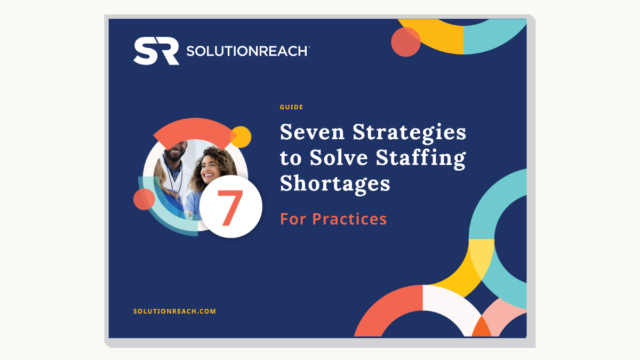Healthcare practices across the country continue to grapple with the impacts of higher costs due to inflation and shortages among frontline staff in the healthcare system, which typically requires fewer admin staff members to take on greater workloads and stressors. Not surprisingly, this becomes a vicious cycle that pushes many staff members to the breaking point and leads to higher rates and levels of burnout.
In a U.S. News & World Report article citing a recent study in the Journal of General Internal Medicine, staff burnout among front office staff and receptionists in 2023 is as high as 46%. Other new research found that nearly 45% of non-clinical staff respondents were overworked. The JGIM research also revealed that as much as 32% of admin staff planned to leave their jobs within two years.
In this article, we’ll identify some of the main causes and factors fueling high burnout rates among front office staff, look at how burnout negatively impacts your practice, and propose strategies and tools to help you prevent fatigue and overload that result in burnout and turnover.
What are the major causes of staff burnout?
Burnout is largely a function of prolonged work-related stress for admin support staff who work in a fast-paced, often short-staffed office. Continual exposure to a high-stress environment can lead to feelings of cynicism, detachment, emotional exhaustion, negative impacts on mental health, and an overall sense of ineffectiveness.
The main factors include but aren’t limited to the following:
- Long hours
- Burdensome administrative workloads
- Inadequate practice management support
- Lack of control over the work environment
- Chronically understaffed offices
How much can staff burnout impact your practice?
There’s a seemingly unlimited amount of pressure on your front office team to check in patients, check insurance, book appointments, manage the schedule, and a long list of other duties and responsibilities. When they’re feeling overwhelmed and under-appreciated, it can inflict palpable negative consequences on your practice’s productivity and efficiency, while the team can feel a sense of a lack of personal accomplishment due to their inability to complete all of their tasks in a day.
Other ways burnout can hurt your practice include:
- Reduced employee job satisfaction and performance
- Absenteeism or a lack of self-care
- High turnover rate
- Decreased quality of customer service
Worst of all, the prevalence of burnout among your staff members makes it more difficult to deliver high-quality patient care when they need it, which can lead to higher operational costs and exacerbate patient health disparities.
How can I prevent burnout at my practice?
A proven way to combat frontline staff burnout is to lighten their load by minimizing repetitive manual tasks and helping them work more efficiently within streamlined workflows. This will help any size front desk team be more productive, process more patients, and result in not only happier patients but greater job satisfaction for admin staff.
To accomplish this, you’ll need a modern patient communications solution that automates tasks, sends reminders and recall notifications, and other tools to streamline your processes and get your staff off the phones.
Consider these best practices and digital tools to better support your front office staff. Every effort to help them do their jobs quicker, easier, and more effectively will pay dividends when it comes to happier employees, lower turnover rates, and operating a more productive and profitable practice.
1. Automate Monotonous Tasks
Automated patient communications tools like appointment reminders, recall, digital form intake, and payment reminders shrink workloads by automating patient messaging, processes, and transactions. These solutions save your staff time, offer more convenient and personalized patient-provider communication, and improve the patient experience.
2. Get Your Team Off the Phones
High rates of phone calls waste a lot of your team’s time, prevent them from completing other priority tasks, and make staff members feel like their brain is in a blender. Minimize calls and enhance patient communication with tools like appointment reminders, recall notifications, text to pay reminders, and batch messaging. Reduce incoming call volumes, personalize your patient messaging, and simplify appointment workloads. It will give them a chance to catch their breath and spend more time on higher-level tasks and reduce administrative burdens.
3. Consolidate Your Software Licenses
It’s incredibly difficult for your admin team to be productive and interact efficiently with patients when they’re using a Frankenstein combo of different software and systems. Having to switch between various vendor tools that lack interoperability flusters staff members and requires them to jump through endless hoops to do their jobs. By consolidating your patient communications and office operations software licenses into a single easy-to-use platform, you can save your staff loads of time and frustration while saving big time on your patient technology costs.
Key Takeaways
Staff burnout is just a fact of life in today’s healthcare system, affecting every practice and healthcare organization. But practice managers aren’t powerless; you can take preventive measures and implement interventions to limit its effects and better support your admin team. Make staff positions more fulfilling and rewarding using strategies and tools to minimize repetitive manual tasks, reduce phone calls, shrink turnover, and offer a more satisfying employee experience for your staff’s well-being. Patient communications software not only lightens the load for your staff and saves them time but also provides greater productivity, efficiency, and profitability for your practice.

For more tips, techniques, and best practices on how to prevent staff burnout that leads to turnover and an understaffed office, download the guide, “Seven Strategies to Solve Staffing Shortages for Practices.”
Read the Guide


